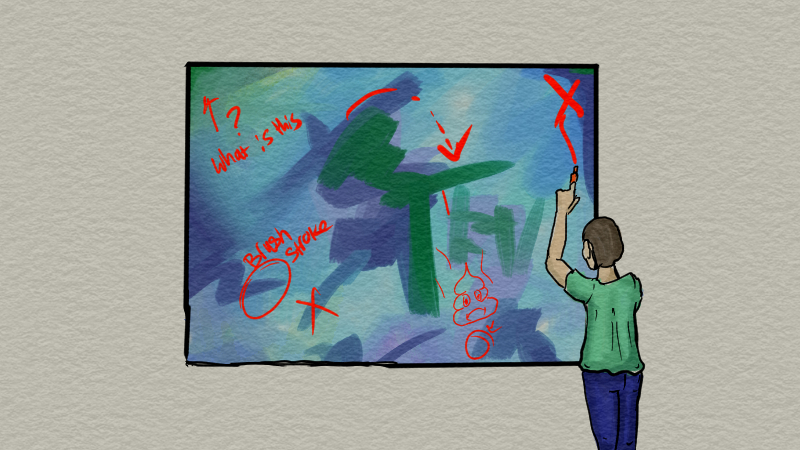How to Give and Receive Critiques to Boost your Art Skills
One of the most essential parts of growing as an artist is giving and receiving critiques. Most art schools or classes will go over this early in the curriculum to give a deeper insight on how to give constructive and meaningful criticism. One of the greatest achievements of our current technology is the ease of access to an infinite amount of education at a moments notice, for virtually any subject you can possibly think about. The downside of this form of education is that it can create bad habits without individualized corrections, it can also skip important foundational elements of the subject you are learning. This is why having a community and giving and receiving criticism is so strong, you will have different minds looking over your work to get over your hurdles. By giving criticism, you will also spotlight mistakes you make by way of showing others. Those ideas solidify in your mind and you won’t repeat them. We will go over some things to think about while giving criticism of other peoples work, these are suggestions I have learned from different classes, teachers, mentors, and from other artists.
1. Keep it Short
When giving a critique, keep it short. The most effective way of communicating is to be concise and clear about the point you are trying to make. There is no point in using flowery language to impress the person you’re talking to. They don’t care. By being short and direct, it will help them far more than you trying to beat around the bush.
2. Compliment and be Tactful
Many people assume that being direct also means being rude. That is absolutely not the case, you can be direct and still have tact. A way of doing this is first explaining what you liked about the piece. What moved you? What ideas did it conjure up when you saw it or read it? If it was a positive experience, why?
3. Be Specific in a Macro View
I know that sounds like a contradiction, but it is an important note. You can look over a piece in a macro view and still be specific about detail. An example of this would be commenting on the composition of a painting and how it affects the viewer or a lull or gap in a story that bores the reader. We’re not talking about brush strokes or certain sentences because those are already implied by talking about the bigger picture.
4. Picking on Details
Now that you have the macro view out of the way, what about the nitty gritty details of brushstrokes or sentences? Depending on the medium, it might be a great suggestion, or it might be a style choice. There is a thin line in art about breaking rules, some people will use style as an excuse for bad foundational knowledge. It’s important to recognize the difference and speak about those. Before you start talking about specific details, ask yourself, does this person understand the basics and is purposely breaking them for effect and intrigue, or do they not understand the concepts in the first place? Remember to be tactful as you bring it up.
5. Comment on Technique, Not Content
This is a kind of bridge between the last point and the next one, but it is important while giving a critique. Don’t focus on the content of the piece or how you specifically feel about the piece of art. Your opinion on what it is displaying is on the lower rungs of what is important. Your goal as a critic in an art setting is to help your fellow artist evoke the feeling that they are trying to convey. Whether it be good or bad. Someone once told me that what makes something a piece of art is that it makes you feel something, regardless of the direction of the emotion. That is what we are trying to focus on.
6. Don’t Rewrite their Story
Like I said in the previous point, your goal is not to change their narrative or content. It is your job to point out gaps or troubles and to help show them how they can correct it to the tune of their own horn, so to speak.
7. Being Critiqued
I’ve given a few examples on what to do if you a critiquing a piece, but what about if you’re the one being critiqued? It is important to remember to not take anything personal. A good piece of advice I learned from author Paulette Perhach in her book Welcome to the Writer’s Life is to take notes while they are talking. Don’t stare at them directly in the eyes as they burn your child at the stake, allow them the space to explore and talk about your piece, I promise you will leave unscathed and you will have a better understanding than when you came in.
8. The Most Important Rule!
The most important thing you must know about being critiqued is, take everything with a grain of salt. No one in the world has the universe or art figured out and they could easily be making a mistake when critiquing your piece. Take everything in and sort it by what makes the most sense, what did they say that made you see it slightly different? Be open about it. I know how much art can mean to the creator, but you must keep mind that the ego does nothing to help you. Ego is ignorant and lives for instability. Think like water and grow like plants, and you will always be better than the day you were before.
There are my tips for effective critiquing and growing your knowledge as an artist. Please feel free to contact me if you have any suggestions or feel like I missed something.
Note: As an Amazon Associate I earn from qualifying purchases from links provided that direct towards Amazon. I was not paid, endorsed or been in contact with the company in any way for this product review








